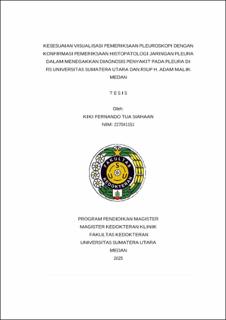Kesesuaian Visualisasi Pemeriksaan Pleuroskopi dengan Konfirmasi Pemeriksaan Histopatologi Jaringan Pleura dalam Menegakkan Diagnosis Penyakit pada Pleura di RS Universitas Sumatera Utara dan RSUP H. Adam Malik Medan
Conformity of Pleuroscopy Visualization with Confirmation of Pleural Tissue Histopathology in Establishing the Diagnosis of Pleural Diseases at the Universitas Sumatera Utara Hospital and Adam Malik Hospital Medan

Date
2025Author
Siahaan, Kiki Fernando Tua
Advisor(s)
Soeroso, Noni Novisari
Harahap, Okto Mara Fandi
Eyanoer, Putri Chairani
Metadata
Show full item recordAbstract
Background: Pleural diseases are often found in daily clinical practice where the diagnosis of the underlying disease is often difficult to establish so that pleuroscopy is needed which plays a significant role in diagnosing and determining therapy for pleural disease. Therefore, data is needed to assess the conformity between pleuroscopic visualization findings and histopathology results in establishing a diagnosis of pleural disease.
Aim: This study aims to determine conformity of pleuroscopic visualization findings and histopathological examination results in patients who underwent pleuroscopic procedures.
Material and Methods: This is an observational analytical study. Patient characteristics data including name, age, gender, symptoms, chest X-ray images, and/or chest CT scans were obtained from medical records. In addition, data of examination results which is pleuroscopy and histopathology examination were also taken from medical records. The analysis was performed using Medcalc software and presented with several diagnostic and accuracy indicators (significance level 95%, α 0.05).
Results: Pleuroscopic visualization findings in accordance with histopathological examination results which indicated malignant pleural effusion was found in 28 patients and non-malignant pleural effusion in 8 patients. Conformity of pleuroscopic visualization method with histopathological examination which is considered as gold standard examination for identification pathological pleura conditions showed a sensitivity level of 96.55%, a specificity level of 38.09%, a Positive Likelihood Ratio (PLR) of 1.560, a Negative Likelihood Ratio (NLR) of 0.091, a Positive Predictive Value (PPV) of 68.29%, a Negative Predictive Value (NPV) of 88.88% with an accuracy level of 72.0% to differentiate malignant and non-malignant pleural effusion.
Conclusion: Pleuroscopy is a useful method for pleural pathological diagnostics with a high sensitivity value.
Keywords: Pleuroscopy Visualization, Histopathology, Pleural Disease, Malignancy, Tuberculosis
